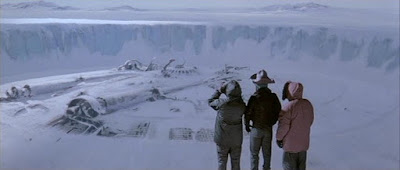(1985) Written and directed by Dario Argento; Starring: Jennifer Connelly, Donald Pleasence, Daria Nicolodi
Available on DVD
Rating: **
Oh boy, where to start? Dario Argento is not generally known for his coherent plots, but Phenomena takes this conceit to new levels. It feels as if ideas from several movies were smooshed together to achieve this end result, which borrows liberally from other, superior Argento films. If I had to describe Phenomena to someone (other than “What the heck did I just watch?”), it would be giallo with a supernatural horror twist.
One thing you can’t accuse Mr. Argento of is creating a slow buildup. He believes in diving into the deep end from the get-go. No kiddie pool for him! In the opening scene, a high school-aged girl misses her bus, and is left on a deserted highway in the middle of the Alps. She discovers a secluded house, and unwisely wanders inside, shouting, "I'm a foreigner, and I'm lost" (No, I didn’t make that up.), oblivious to the fact that she’s virtually ringing the dinner bell for whomever might be lurking inside. Naturally, this alerts the presence of an unseen stalker, and before you can say “plot convenience,” she becomes the film’s first victim.
We’re then treated to a non-sequitur voiceover narration, introducing the main character, Jennifer Corvino, played by a teenaged, pre-Labyrinth Jennifer Connelly. Whatever happened to the narrator is unknown, as he’s never heard from again. Perhaps he was another murder victim?
Jennifer is the token American in an exclusive Swiss boarding school, run by an authoritarian headmistress. She takes up residence in a room formerly occupied by the murdered girl from the opening sequence. If this sounds more than a little familiar, substitute German for Swiss, and you’ll be left with a setup straight out of the much better Suspiria. Jennifer has the power to communicate with and control insects, with the stray arachnid thrown in for good measure. Additionally, she tends to sleepwalk at night, in heavy metal-drenched sequences that wouldn’t have been out of place in an MTV music video of the era. This doesn’t win points with the headmistress or her fellow classmates, who regard her with suspicion and contempt. After two other girls die in typical over-the-top Argento fashion, Jennifer begins to see a connection with the murders through her somnambulistic dreams.
Her only ally is wheelchair-bound Professor John McGregor, played by the usually reliable Donald Pleasence. McGregor is a Scottish entomologist working in Switzerland, giving Pleasence an opportunity to employ a not entirely convincing Scottish brogue. His laboratory is populated by the usual assortment of creepy crawlies that you’d expect to see. True to his vague movie scientist roots, his research apparently doesn’t focus on one particular species, but involves all terrestrial arthropods. He’s assisted by a sometimes knife-wielding chimpanzee who threatens to steal the show. Pleasence’s scenes with Connelly work the best, and some of their dialogue is mildly intriguing as he attempts to come up with a pseudo-scientific explanation for her psychic link between the insects. Before long, they conclude that the insects can lead her to the killer, setting her off on a lone quest, against any semblance of good judgment.
If the first two thirds of Phenomena were shaky, it’s the bugnuts (sorry, I couldn’t resist) third act that takes complete leave of its senses. Up to this point, spontaneous musical interludes and insects aside, it’s a fairly straightforward murder mystery plot. Things start careening out of control, once Jennifer decides to look for the killer herself. Without giving too much away, the reveal of the killer seems completely arbitrary. Instead of shock or surprise, I was left with a big huh? I’m not an expert on building a well-crafted mystery screenplay, but I believe the first step would be to start with some possible suspects, and build suspense through character development to raise logical doubts about one or more of the suspects. The big reveal should be earned, not random or tacked on. But then again, that’s just me. This eventually leads to a deus ex machina ending that has to be seen to be believed.
Jennifer’s choices shift from questionable to downright stupid. Her actions seem preordained in the script, instead of consistent with anyone possessing more than a brain stem. (Minor spoiler alert!) Late in the film, she’s led to the lair of the killer, only to fall into their trap. Word to the wise: if you’re ever stuck in the house of someone who seems mentally unstable and they insistently hand you some strange pills, don’t take them.
Phenomena is a complete mess from start to finish. It’s not entirely devoid of entertainment value and it’s never boring, but that doesn’t mean it’s a good film. Your own enjoyment of the movie will probably depend on your tolerance for Argento’s trademark over-the-top kills, along with plot twists that make no sense at all. If that sounds like your cup of tea, then have at it. I think I’ll just watch an old Hitchcock flick instead.





















